This article has mentions of products from one or more companies, and I may receive compensation if you purchase those products following reading my recommendations.
An I color diamond is known as one of the ‘near-colorless’ diamonds, as defined by the Gemological Insititute of America’s (GIA) color scale. What this usually means is that, to the naked eye, an I color diamond appears colorless. However, under close analysis using technology, a slight yellow coloration would be noticeable.

As you can see from the GIA color scale, which is the most commonly used scale amongst diamond retailers, I sits near the end of the near-colorless portion. The grades below this portion, such as K and L, have a yellow tint that’s visible to most people.
Knowing this, is an I color diamond worth purchasing? We’ve got the answers for you.
What is Diamond Color?
When a diamond is formed, it’s made from carbon atoms. Sometimes, the formation process can also bring in atoms of nitrogen. This is what causes some diamonds to have a yellow color.
While it’s quite easy to find colorless diamonds, many will have the presence of nitrogen naturally. Miniscule amounts won’t affect the color of the diamond enough to be seen, but if there are enough, then the presence of the yellow hue (and even brown hues) will be noticeable.
So, diamond color is essentially the presence of things other than carbon within the structure of the diamond. If you’re interested in more information on the subject of diamond color, head to our diamond color education page.
Comparing I Color Diamonds with Other Grades
I color isn’t the highest color grade available (which is D). You might assume that due to its fairly middling position, there’s a noticeable yellow hue to an I diamond. Fortunately for you, that assumption isn’t correct. As the GIA’s color scale extends all the way to Z, there’s a wide margin of near-colorless diamonds to enjoy before you even start to see yellow.
When cut well, I color diamonds can look colorless. Take the diamond below, available at Whiteflash. It’s a 1.08 ct I VS1 A CUT ABOVE® Hearts and Arrows Diamond. As you can see, it’s very hard to see any yellow tint. But be warned, yellow hues are hard to see top-down, but are easier to notice from side-on, which you can slightly notice below.
 |
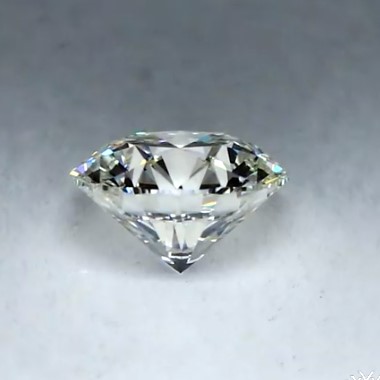 |
Compare that to this diamond of a lower quality cut offered by James Allen.
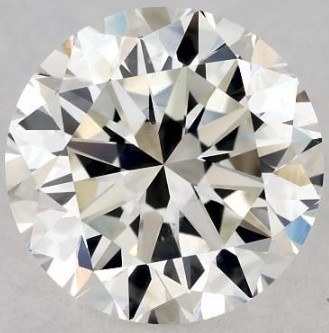 |
 |
Image credit: James Allen
This is a 1.00 Carat Round Diamond, crafted with a ‘good cut’. As you can see, there’s a distinct difference in how much yellow you can see. Now, there may also be differences in how Whiteflash and James Allen light their diamonds when they’re being photographed, which you should always take into account. However, differences in cut do affect the way light interacts with the diamond itself, and a lesser quality cut will bring more attention to any imperfections.
Another key fact you should remember is that Round Cut diamonds are the best at disguising color. Other shapes, such as Pear, or Emerald, will appear yellower if they’re lower down on the color scale.
Pricing an I Color Diamond
Many people think of carat or clarity as being the main factors affecting the price of a diamond, and they wouldn’t be wrong. A 30 ctw diamond would naturally cost more than a diamond coming in at 1 ctw. However, color has an important influence over price too.
Colorless graded diamonds will be more expensive than near-colorless counterparts (unless the near-colorless diamond dwarfs the colorless in terms of carat weight). Look at these two diamonds:
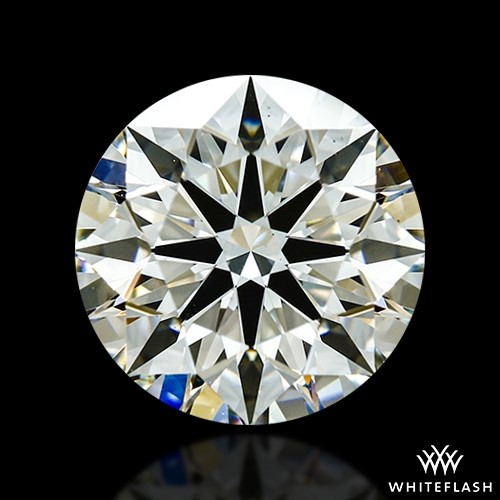 |
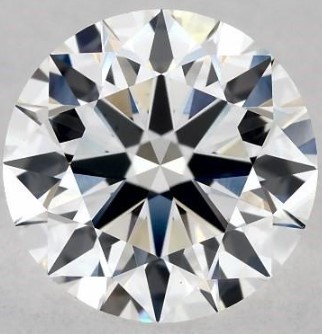 |
| Color: I | Color: D |
| Clarity: VS1 | Clarity: VS1 |
| Carat: 1.058 ctw | Carat: 1.04 ctw |
| Cut: Ideal | Cut: True Hearts |
The first diamond, from Whiteflash, is an I color diamond, VS1 clarity, and has an Ideal cut (the highest Whiteflash advertise). The second diamond, from James Allen, is a D color, VS1 clarity, and has a True Hearts cut (equivalent to Ideal). They’re both beautiful diamonds, but the diamond to the right costs over $2,000 more. What’s interesting is that the I color diamond is actually 0.18 ctw larger, and yet still, the difference in color contributes to a much less expensive price for the Whiteflash diamond.
In such a scenario, you could choose the Whiteflash diamond, which is just as impressive, and save yourself money and still end up with a larger diamond. But personal preference is also important and, if you prefer a colorless diamond, the D-graded diamond would be a wise choice.
Should You Buy an I Color Diamond?
As you might have realized already, as long as you’re purchasing an eye-clean, well-cut I color diamond, there’s really no reason not to buy one. However, as we mentioned, other diamond cuts may draw more attention to any yellow hues present in an I color diamond, so we would recommend you purchase a Round Cut. This is especially important if you’re choosing a diamond that will eventually make its way into an engagement ring.
Before making any purchases, do read my reviews on other jewelers such as Whiteflash, Brilliant Earth and Blue Nile, Whiteflash have a better quality cut diamond with their A CUT ABOVE® Diamonds, Brilliant Earth have fantastic lab diamonds and for cheaper options then Nile is best.
Using I Color Diamonds in Settings
Diamonds tend to take on some of the color of the setting they’re in, through the reflection of light between the two. If you choose a yellow gold engagement ring, the diamond set within is likely to have a very slight yellow gold tint at times.
This is both a blessing and a curse to the I color diamond buyer. If you set a near-colorless diamond in a yellow gold setting, any yellow that exists within the diamond has the potential to be amplified, which is the opposite of what you want.
For anyone choosing an I color diamond to set into jewelry—especially an engagement ring—we would recommend choosing white gold or platinum as the metal used for the setting. Going for white gold or platinum will mean that the white sheen of those metals will ‘bleed’ into the diamond, nullifying the presence of yellow tones.
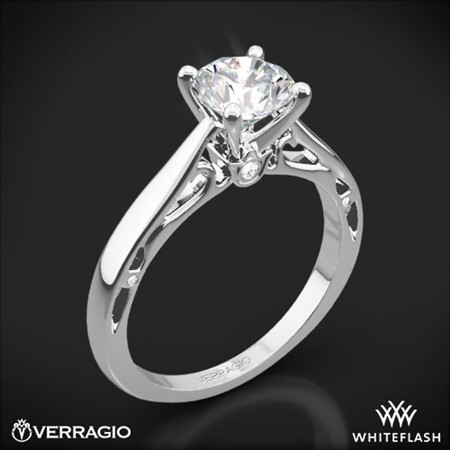
Imagine setting your carefully chosen diamond into this beautiful 18k White Gold Verragio Cathedral Solitaire Engagement Ring, resulting in a truly impactful, irresistible piece of jewelry. Image credit: Whiteflash
Additionally, if you decide purchase an engagement ring with more than one diamond, you need to make sure that the I color diamond appears colorless in relation to the other diamonds present in the piece. When choosing with a three-stone, halo, or pavé ring, ensure that the stones used in these pieces are close to your I color diamond on the GIA color scale.
If you’re unable to find settings with similarly color-graded diamonds, consider purchasing a different diamond with a similar color grade, or choose a solitaire ring design, which features only one stone.
Our Final Thoughts
If you’re taking our advice and putting effort into researching what available I color diamonds offer the best value for money, there’s no reason why you should have issues when purchasing these types of diamonds. Remember:
- If buying near-colorless diamonds, choose Round Cuts to better disguise color.
- When choosing a setting, opt for white gold or platinum to further negate the presence of any yellow.
- If choosing an alternate diamond shape or pairing with other diamonds, it may be worth choosing a higher color-graded diamond.
Opting for an I color diamond will allow you to save money versus those with higher color grades, meaning you could potentially buy a larger diamond or choose a more expensive setting.
So where can you find the right diamonds? Fortunately, we’ve done a lot of the legwork for you already. All you need to do is head to our diamond reviews section, where you can look into the best diamond organizations operating today and see which one appeals to you the most.
